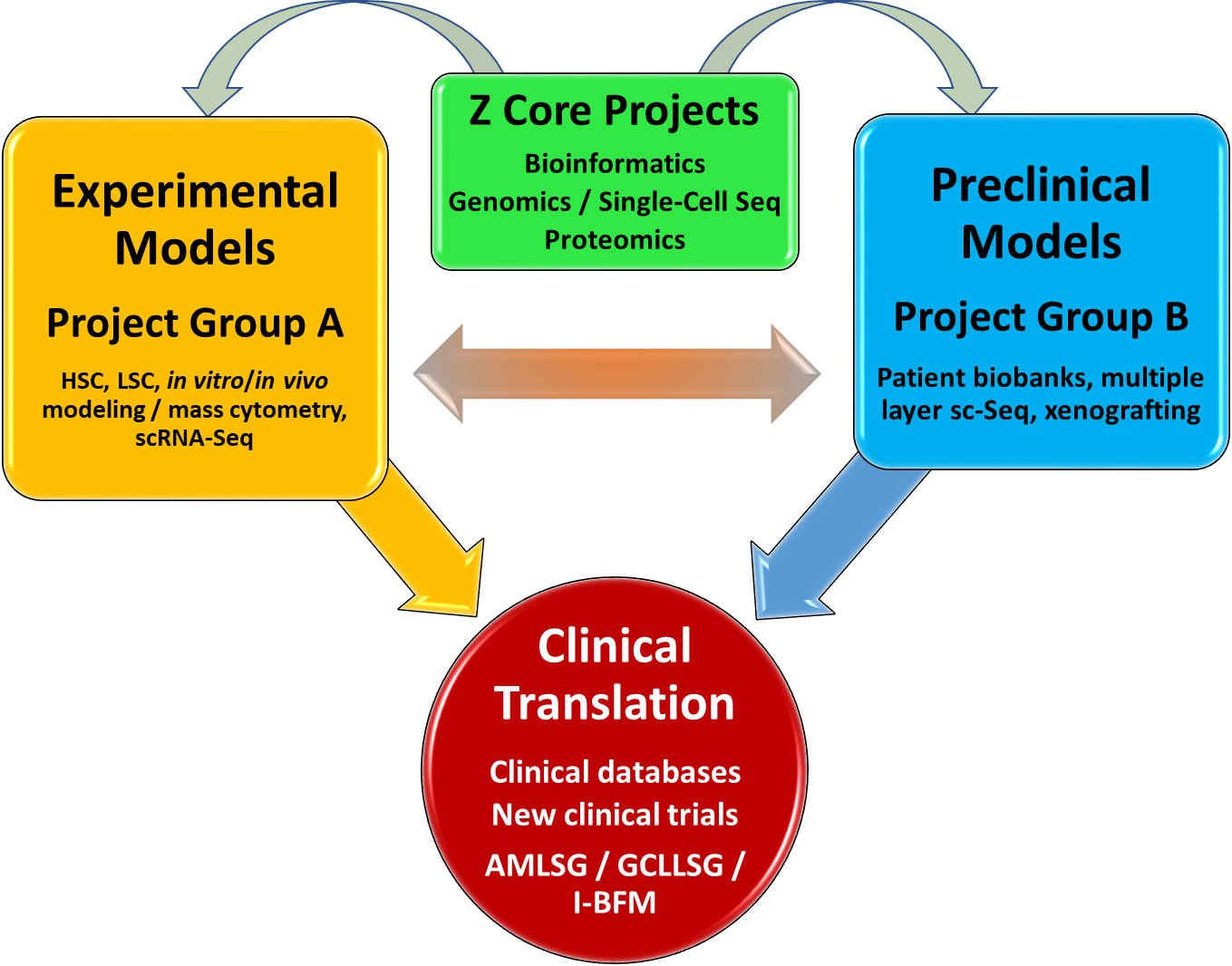A Brief Summary of SFB 1074 Projects
Over the past decade, basic research with characterization of oncogenetic events in the hierarchy of hematopoiesis, preclinical research in tumor models, translational research with identification of novel targets and, ultimately, targeted therapy against pathway lesions have been at the frontline of progress in clinical research in general and have led to significant progress in the care of patients with leukemia. The availability of modern technologies in the “omics” area, in combination with well-annotated biobanks of large patient groups in clinical trials as well as leukemia models that closely resemble human disease, has opened the window for immediate transfer of discoveries on oncogenic targets and pathways for targeted therapies.
Ulm University has a long-standing tradition in hematology with one of the first Collaborative Research Centers (CRC) of the DFG (“Zellsystem-Physiologie”) addressing issues of normal and aberrant hematopoiesis and first hematopoietic cell transplantations, in both children and adults, performed in Germany. Throughout its history, research on blood disorders and leukemia has been one of the central pillars of the profile of Medicine in Ulm and the University in general. Along this line, recruitments to central positions in the Medical Faculty have always been strongly guided by keeping hematology and in particular leukemia as a central focus.
CRC 1074 is in the core of this central pillar. Based on the highly visible expertise in Ulm, projects were brought together in the first funding period that address basic aspects of genetic lesions and pathways involved in leukemogenesis in molecular studies as well as in experimental leukemia models, using genomic mouse technology, complemented by programs that directly involve genomic studies and preclinical models to characterize sensitivity and resistance in CLL, AML and ALL. Significant progress has been made not only in the individual projects, but also in bringing together so far distinct research programs and technologies. Results of programs in the previous period have led to hallmark papers with immediate clinical implications mostly addressing novel targets of therapy in CLL and AML. Projects within CRC 1074 also led to novel concepts of aging and damage responses in hematopoietic stem cells. Preclinical mouse models have been developed and expanded to cover a spectrum of genetic models and “co-clinical” models and trials in immunodeficient mice on a range of leukemia subgroups have identified novel therapeutic targets and therapeutic approaches.
Based on the now well-established models and expanding on the leukemia biobanks, the projects for the second funding period will continue and even increase the focus on specific leukemia-associated oncogenic lesions, deregulated pathways and/or putative therapeutic targets. As an asset to our program on lymphoid leukemias (CLL, ALL), specific signaling projects and a strong epigenetic project on prolymphocytic leukemia will be added. The Steering Committee went through several rounds of selecting and shaping the research projects for the second funding period into a comprehensive program addressing leukemia cell biology and its translation into the clinic. We expect that the second round will significantly increase the immediate clinical translation of the research projects within the CRC.
Here is a brief overview of our projects.
Structure of the Research Program
The structure of CRC 1074 will remain with two closely interacting Project Groups: Group A projects with the expertise in experimental models, and Group B projects focusing more on translational / preclinical work (see Figure). The individual projects will be complemented by two core projects, the Next-Generation Sequencing (NGS)/Bioinformatics Core that has been and will continue to be a key asset to the CRC, and the Mass Spectrometry and Proteomics Core added in the second funding period that will continue to provide access to state-of-the-art proteomics studies. The NGS/Bioinformatics Core will be further developed and will now implement a strong focus on single-cell sequencing technologies with the new principal investigator (PI) Karsten Rippe from the German Cancer Research Center (DKFZ) in Heidelberg.

